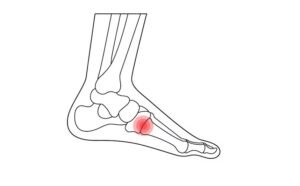7777 Warren Parkway, #370 Frisco, TX 75034
Welcome to Chiropractor of Frisco, TX !
-
Call for help: 469-516-2225
Welcome to Chiropractor of Frisco, TX !
Call for help: 469-516-2225

Plantar fasciitis occurs when the thick band of tissue (called the plantar fascia) that connects the front of your foot to your heel becomes overly stretched. This makes the tissue sensitive and swollen, which makes the heel pain.
Plantar fasciitis pain is often more severe after a period of rest—for example, after a long car ride, or while taking your first few steps out of bed in the morning. The condition can make it difficult to exercise, play sports, and perform daily activities. It can also interfere with your ability to work, especially if you spend a lot of time on your feet.

Getting rid of plantar fasciitis means making changes to your habits that make your feet less stressed. Wearing shoes with extra cushioning and hip support is one of the most important things you can do. The plantar fascia can get more stressed when you walk barefoot on hard ground.
Your feet and calves will stay flexible if you do stretching movements regularly. The plantar fascia, Achilles tendon, and leg muscles should all be stretched. Getting the muscles in your feet and lower legs stronger can also help.
Keeping a healthy weight is very important if you want to keep your feet from hurting. If you are overweight, you might want to lose weight by following a healthy diet and working out regularly. Keep in mind that losing weight slowly is more likely to last and put less stress on your body.
Mild cases of plantar fasciitis can usually be treated at home, but if the pain lasts for a long time or is very bad, you may need to see a doctor. If your symptoms don’t get better after taking care of yourself for a few weeks, you should see a doctor.
An experienced chiropractor can carefully examine you to find the root cause of your pain. After that, they can make a treatment plan just for you that fits your needs. To rule out other diseases, it may be necessary to do more diagnostic tests, like X-rays or MRI scans.
To stop persistent pain and long-term damage to the plantar fascia, it’s important to act quickly. If you’re having trouble with heel fasciitis, don’t be afraid to get help from a professional.
One of the best things about chiropractic care is that it focuses on fixing the problem at its source. By realigning the spine and fixing any problems with the feet or legs, chiropractors can take pressure off the plantar fascia and make the feet work better overall.
Adjustments from a chiropractor can also help get more blood to the hurt area, which speeds up the healing process. Chiropractors can also give you specific tips on shoes, exercises, and changes to your lifestyle that can help stop flare-ups from happening again.
We’re proud to have helped many people with heel fasciitis get better at Infinity Wellness Chiro. Here are some success stories from clients who were happy with our work:
I was hesitant to accept the care at first, but Dr. Nathan Hansen and his staff provided excellent, personalized care. I feel fantastic and am pain-free now.” — Mark R.
The success stories of other people gave me hope. It only took a few lessons for the pain to go away for good. I strongly suggest that anyone with plantar pain visit Infinity Wellness Chiro. — Emily L.